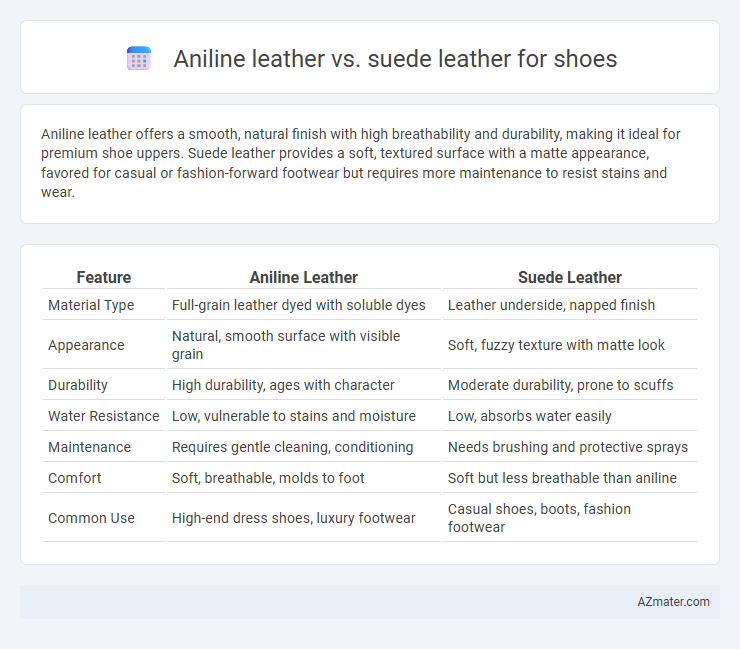Aniline leather offers a smooth, natural finish with high breathability and durability, making it ideal for premium shoe uppers. Suede leather provides a soft, textured surface with a matte appearance, favored for casual or fashion-forward footwear but requires more maintenance to resist stains and wear.
Table of Comparison
| Feature | Aniline Leather | Suede Leather |
|---|---|---|
| Material Type | Full-grain leather dyed with soluble dyes | Leather underside, napped finish |
| Appearance | Natural, smooth surface with visible grain | Soft, fuzzy texture with matte look |
| Durability | High durability, ages with character | Moderate durability, prone to scuffs |
| Water Resistance | Low, vulnerable to stains and moisture | Low, absorbs water easily |
| Maintenance | Requires gentle cleaning, conditioning | Needs brushing and protective sprays |
| Comfort | Soft, breathable, molds to foot | Soft but less breathable than aniline |
| Common Use | High-end dress shoes, luxury footwear | Casual shoes, boots, fashion footwear |
Introduction to Aniline and Suede Leather
Aniline leather is a type of full-grain leather dyed with soluble dyes that preserve the natural surface, showcasing distinctive grain patterns and providing a soft, breathable texture ideal for premium shoe uppers. Suede leather is derived from the underside of the animal hide, featuring a napped finish that delivers a velvety texture and a lightweight, flexible feel, commonly used for casual and fashion-forward shoes. Both leathers offer unique aesthetics and comfort but differ significantly in durability and maintenance requirements.
Characteristics of Aniline Leather
Aniline leather is characterized by its natural appearance, showcasing the full grain and original texture without surface coatings, which allows for breathability and softness ideal for high-quality shoes. Unlike suede leather, which has a napped finish created by sanding the inner surface, aniline leather maintains its durability and strength while developing a unique patina over time. The premium, untreated surface of aniline leather is prone to stains and requires careful maintenance compared to the more textured, casual look of suede.
Properties of Suede Leather
Suede leather, derived from the underside of animal hides, features a soft, napped finish that offers a unique texture and a luxurious feel ideal for stylish shoes. Its porous surface provides better breathability compared to aniline leather but requires careful maintenance due to higher susceptibility to water and stain damage. Suede's flexibility and lightweight nature enhance comfort, making it a preferred choice for casual and fashionable footwear where softness and appearance are prioritized.
Durability Comparison: Aniline vs Suede
Aniline leather offers superior durability compared to suede leather due to its full-grain natural surface, which retains strength and resists wear and tear effectively. Suede leather, made from the underside of the animal hide, is more susceptible to scuffs, stains, and moisture damage, reducing its lifespan in high-usage footwear. Shoes crafted from aniline leather maintain structural integrity and appearance longer, making them a preferred choice for durability-conscious consumers.
Comfort and Wear Experience
Aniline leather shoes offer superior breathability and a natural, soft feel, making them highly comfortable for extended wear due to their minimally processed surface that retains natural oils. Suede leather provides a plush texture and flexible wear experience, but may require more maintenance to retain softness and avoid staining, impacting long-term comfort. Both materials deliver distinct tactile sensations, with aniline favoring durability combined with a smooth finish, while suede emphasizes a velvety touch ideal for casual, relaxed wear.
Maintenance and Cleaning Requirements
Aniline leather requires careful maintenance with regular use of specialized leather conditioners to preserve its natural finish and prevent staining, as it lacks a protective topcoat. Suede leather demands frequent brushing with a suede brush to remove dirt and maintain texture, while using waterproof sprays to protect against moisture damage. Both materials benefit from avoiding direct exposure to water and contaminants, but aniline leather is generally easier to clean with gentle leather cleaners compared to the more delicate and porous suede.
Water and Stain Resistance
Aniline leather offers excellent water resistance due to its minimally treated surface with natural dyes, allowing it to repel light moisture while maintaining breathability. Suede leather, characterized by its napped finish and open pores, is highly susceptible to water absorption and stains, requiring protective sprays for enhanced resistance. For shoes exposed to wet or dirty conditions, aniline leather provides superior durability compared to the delicate, stain-prone nature of suede.
Aesthetic Appeal and Style Options
Aniline leather offers a smooth, natural finish with rich, deep color penetration that enhances the shoe's luxurious aesthetic appeal, making it ideal for formal and high-end styles. Suede leather provides a soft, textured surface with a matte finish, offering a more casual and versatile look that complements both sporty and fashion-forward shoe designs. The choice between aniline and suede leather influences the shoe's overall style, durability, and suitability for different fashion occasions.
Price and Value Considerations
Aniline leather shoes typically command higher prices due to their natural, untreated surface that showcases the leather's authenticity and breathability, offering superior durability and premium aesthetics. Suede leather shoes, often more affordable, provide a softer texture and casual look but require more maintenance and are less resistant to stains and water. When considering value, aniline leather generally offers long-term investment benefits through its resilience and timeless appeal, while suede caters to budget-conscious buyers prioritizing style over heavy-duty performance.
Which Leather is Best for Shoes?
Aniline leather offers a smooth, natural finish with excellent durability and breathability, making it ideal for high-quality shoes that require a polished yet comfortable look. Suede leather provides a soft, textured surface with a velvety appearance, preferred for casual and stylish footwear, but it is less durable and more prone to stains and water damage. For long-lasting, versatile shoes, aniline leather is the better choice due to its balance of elegance and resilience, while suede suits fashion-forward designs where softness is prioritized over durability.

Infographic: Aniline leather vs Suede leather for Shoe
 azmater.com
azmater.com